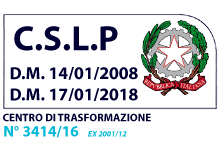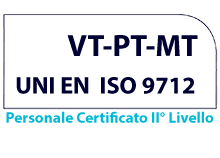Certified Railings, Law and Calculation Standards
Major regulatory references for the calculation and construction of steel rails or balustrades.
(n.b. According to Italian law)
With a view to contributing to greater clarity on the matter below, we list a list that we hope will be as comprehensive as possible of the major law and calculation rules governing the construction and supply of Parapets or Balustrades for Terraces and Stairs.
1) Regulation (EU) 305/2011 of the European Parliament and of the Council of 9 March 2011
Obviously, operating in the European Economic System is crucial to first mention the key regulation under which products can be produced and freely marketed throughout the EEA
This Regulation establishes harmonized conditions for the marketing of construction products and repeals Council Directive 89/106 / EEC (Text with EEA relevance) The full text of the regulation can be consulted at the following link: ![]() (UE)305/2011.pdf
(UE)305/2011.pdf
The Regulation applies to all products (materials, artifacts, systems, etc.) that are made to become permanent parts of construction works (buildings and civil engineering works), which must ensure compliance with at least one of the following requirements set in Annex I
Construction works, in their entirety and in their individual parts, must be suitable for the intended use, taking particular account of the health and safety of the persons concerned throughout the life cycle of the works. With the exception of ordinary maintenance, construction works must meet these basic construction requirements for a service life of a reasonable duration.
- Mechanical Resistance and Stability;
Construction works must be designed and constructed in such a way that the loads to which they may be subjected during construction and use do not provoke:- the total or partial collapse of construction;
- serious and unacceptable deformations;
- damage to other parts of construction works, or to main installations or accessories, as a result of a severe deformation of the load elements;
- Accidental damages that are disproportionate to the cause of the cause.
- Safety in case of fire;
- Hygiene Health and Environment;
- Safety and accessibility in use;
- Noise protection;
- Energy saving;
- Sustainable use of natural resources for the construction of buildings.
The manufacturer's obligations are also specified in order to ensure traceability in order to allow the withdrawal or recall of the product from the market if the manufacturer has reason to believe that the product placed on the market does not comply with the conformity and correspondence given by the CE marking .
he key concept of the new Regulation 305/11, in relation to the CPD Directive 89/106 / EEC, is the "Performance Statement (DoP)" that replaces the previous Conformity Declaration of Construction Products. If the latter attested the conformity of a product to the requirements of a technical standard (Article 13 CPD), the statement of performance:
- is mandatory for all products covered by a harmonized standard; such as: Gate Construction (UNI EN 13241), Balustrades and Railings by UNI 10805-UNI 10809, Metal Carpentry UNI EN 1090-2
- must contain information on the intended use;
- must contain the essential characteristics relevant to the intended use;
- must include the performance of at least one of the essential characteristics;
- the manufacturer assumes responsibility for the declared performance.
The new Regulation modifies market access conditions and, since July 2013, construction products covered by a harmonized standard (and hence subject to CE marking) or subjected to a European Technical Assessment (EEA) may be placed on the market only if:
the manufacturer has drawn up the DoP (Declaration of Performance) for the product;
- the manufacturer has drawn up the DoP (Declaration of Performance) for the product;
- the products for which the DoP has been drawn up are CE marked;
- the consistency of the product's performance has been verified and attested.
2) Ministerial Decree 14/01/2008 (Tenic Standards for Buildings)
The technical standards for buildings collect in a single organic text the rules previously dealt with in several ministerial decrees and "define the principles for the design, execution and testing of buildings in respect of the performance they require in terms of the essential requirements of mechanical strength and stability, even in the event of fire, and durability. They therefore provide the general safety criteria, specify the actions that must be used in the project, define the characteristics of materials and products and, more generally, deal with aspects related to the structural safety of works »
The full text of the Decree can be consulted at the following link:![]() D.M.14/01/2008.pdf or directly from the website of the Higher Board for Public Works at the following address: www.cslp.it
D.M.14/01/2008.pdf or directly from the website of the Higher Board for Public Works at the following address: www.cslp.it
As an informative note, it has been stressed that for some years the offices have been working to issue a new revision of the Technical Building Regulations and for this purpose at the meeting of 14 November 2014 the CSLP has expressed its favorable opinion on the revised draft, dedicated, at the following link:www.CSLP.it/NTC2014 he committee's opinion and the draft revision proposal can be downloaded for information purposes.
Previous Technical Standards for Construction in Italian Legislation
- Ministerial Decree of 30 May 1974, Technical Regulations for Execution of Normal and Pre-Compressed Concrete Works and Metal Structures
- Ministerial Decree of July 27, 1985, Technical Regulations for Execution and Testing of Structures in Concrete and Pre-Compressed Metal and Metal Structures
- Ministerial Decree of 20 November 1987, Technical standards for the design, execution and testing of masonry buildings and for their consolidation
- Ministerial Decree of 9 January 1996, Technical Standards for the Calculation, Execution and Testing of Structured Concrete and Pre-Compressed Structures and Metal Structures
- Ordinance of 20 March 2003, no. 3274 of the President of the Council, First Elements on General Criteria for Seismic Classification of National Territories and Technical Regulations for Seismic Construction
- Ministerial Decree of 14 September 2005, Technical Standards for Construction
As already pointed out in the previous article Certified Railings, General Aspects, the aforementioned decree fixed in Chapter 3 Construction Actions, the horizontal load for which the parapets are to be designed, is specifically designated as a project variable variable load Hk of 2kN / m (Table 3.1.II category C2 Balconies Ballatoi and Common Scales), this load must be applied to the upper part of the handrail.
Il soddisfacimento della prescrizione può essere documentato anche per via sperimentale, e comunque mettendo in conto i vincoli che il manufatto possiede e tutte le risorse che il tipo costruttivo consente.
On discrimination between residential areas (category a) and category C2 Balcony Balconies and Municipal Stairs, it has been widely discussed in dissemination seminars and the key concept is that Scales and Balconies for whatever type of construction is to be the way of exodus or natural harvesting point in the event of a fire therefore are to be considered as areas subject to crowding, for consistency it is possible to note that for the balconies and the stairs the vertical project load is 4kN / m2, for those who are interested we report inl link to the opinion drawn from Dott.Ing. Pierpaolo Cicchiello Progetto dei Parapetti.pdf.
Although the great community of designers is most devoted to the main / primary elements of a structure, it is important to note that such a decree (as the previous ones now repealed) provides that the parapets must resist a certain action, and for that purpose they must be "designed ", while admitting vertebral verification, in fact placing such artefacts between the structural elements of a construction and as indicated in Annex I to Regulation (EU) 305/2011 must meet the requirement of mechanical strength and stability, implying in fact that the parapets must be manufactured by a certified carpentry according to UNI EN 1090 and that such artefacts can not be marketed in the absence of a suitable (DoP), without committing the wrongful act.
3) Circular Ministerial 2 February 2009 n ° 617
Instructions for the Application of the "New Technical Standards for Construction" as per the Ministerial Decree of January 14, 2008. (the text of which can be consulted in full in the address www.gazzettaufficiale.it
By Ministerial Decree 14 January 2008, published in the Official Gazette of 4 February 2008, no. 29, the "New Technical Standards for Buildings" have been approved, a legislative text that gathers unitary rules governing the design, execution and testing of buildings in order to ensure, by established security levels, the public safety '. These norms represent the most advanced normative expression for the protection of public safety in the construction sector, according to a coherent approach to eurocodes and with state of the art content, regarding the timely assessment of the seismic hazard of the national territory and hence to the needs of a modern seismoresist design of civil engineering works to be realized or restructured in Italy; shared by the academic, professional and productive-business world.
These instructions are intended to provide operators with directions, information elements and additions, for a more simple and unambiguous application of the New Technical Standards for Construction.
4) Eurocodes
Eurocode (EC) codes are European standards for structural design.
They align with current national standards and allow the practitioner to use common calculation criteria and can also be used abroad.
In particular, the following are applicable to the design and construction of parapets:
- Eurocodice 0 Uni En 1990-General Structural Design Criteria: Provides basic guidelines for dealing with the semi-propagated limit state design, verification combinations, security factors (unless otherwise specified) for the combination of actions.
- Eurocodice 1 Uni En 1991-Structural Actions: Provides the necessary information to determine the calculation actions on structures, in varying degrees, from loads due to the crowd and snow, wind, thermal loads resulting from a fire, those in the mounting steps and more specific ones on bridges.
- Eurocodice 3 Uni En 1993-Design of steel structures: it is dedicated to steel structures.
- Eurocodice 8 Uni En 1998-Design of Seismic Resistance Structures: It is dedicated to the seismic aspect: it connects to others in relation to the material used (concrete, steel, wood, geotechnics).
5) Standards Uni from 10805 to 10809
- Uni 10805-1999: Railings, balustrades or prefabricated parapets - Determination of static load resistance of columns and columns.
The standard defines a test method for determining mechanical resistance to static loads of columns and columns that are part of railings, balustrades or parapets of any material. The rule applies to prefabricated, unplanned balustrades, balustrades or parapets, and / or installed with the help of masonry works. - Uni 10806-1999: Railings, balustrades or prefabricated parapets - Determination of mechanical resistance to distributed static loads.
The standard defines a test method to determine the mechanical strength of distributed static loads of railings, balustrades or parapets of any material.
The rule applies to prefabricated, unplanned balustrades, balustrades or parapets, and / or installed with the help of masonry works.
This standard defines the mechanical strength test method for distributed static loads of prefabricated railings, parapets and balustrades that function as fall protection As can be seen, the standard dates back to 1999, the year in which the ministerial decree of January 9, 1996 was in force, while the criteria for calculating resistance are still valid, the values of the actions determined by the rules in force should be used. - Uni 10807-1999: Railings, balustrades or prefabricated parapets - Determination of mechanical resistance to dynamic loads
The standard defines a test method to determine the mechanical strength of the dynamic loads of railings, balustrades or parapets of any material.
The rule applies to prefabricated, unplanned balustrades, balustrades or parapets, and / or installed with the help of masonry works.
This Standard defines the test method for the determination of the mechanical resistance to the dynamic loads of prefabricated railings, parapets or balustrades, which have fall protection function, using the pendulum test with a mass device equal to kg 50 and a variable fall height to the intended use As can be seen, the standard dates back to 1999, the year in which the ministerial decree of January 9, 1996 was in force, while the criteria for calculating resistance are still valid, the values of the actions determined by the rules in force should be used. - Uni 10808-1999: Railings, balustrades or prefabricated parapets - Determination of mechanical resistance to static loads on panels
The standard defines a test method to determine the mechanical resistance to static loads concentrated on the railings, balustrades or parapets of any material.
The rule applies to prefabricated, unplanned balustrades, balustrades or parapets, and / or installed with the help of masonry works. - Uni 10809-1999: Railings, balustrades or prefabricated parapets - Dimensions, mechanical performance and sequence of tests
The standard establishes the dimensional characteristics and mechanical performance of railings, balustrades or prefabricated parapets, depending on their intended use and installation environment. It also establishes the functional sequence of performance characterization tests.
Of particular interest this standard defines some of the essential requirements for parapets, among which it is important to cite:
§3.2 Scalability
The various elements of railings, balustrades or parapets must be arranged in such a way as to disadvantage the climbing.
In particular, in the case of balustrades, balustrades or parapets made of horizontal bands, the following dimensional requirements shall be considered:
The bottom of the railing, parapet or balustrade must be blind and with the inner face having a straight profile and perpendicular to the ground plane;
The upper edge of the lower end must be at least 500 mm from the step of the step to the railings, and from the balustrade for balustrades or parapets
For a minimum height of 700 mm from the step of the step for the railings and the tread for balustrades or parapets, the additional bands must be free from light not more than 20 mm it is important to point out that the rule excludes the possibility of making railings with horizontal elements except with lights between the elements below 20mm in the first 70cm from the treadmill, or alternatively with blind protection (glass or sheet) for the same height as to prevent climbing, no observation can be detected on the use of handrails disassembled with the projection of the parapet in fact it is not possible to consider such a sufficient solution to prevent scalability.
§3.3 Invertability
Railings, balustrades or parapets shall be able to be crossed at any point by a sphere of 100 mm in diameter
§4 MECHANICAL PERFORMANCE
...
§4.2 Mechanical resistance to distributed static loads
Prefabricated railings and balustrades, which have fall protection function, must be subjected to the test defined in 10806, at the end of the test no breakage or degradation may be encountered which could compromise the user's safety requirements for the produced at project stage. However, the deformation arrow under load must not be greater than 2% of L where L is the total sample length, and in any case it must not be more than 60mm Maximum residual deformations equal to 0.2% L, but not more than 6mm, are allowed
§4.3 Mechanical resistance to dynamic loads
Prefabricated balustrades and balustrades, with a fall protection function, shall be subjected to the test defined in UNI 10807.For the end of the test, there shall be no breakage or degradation that may compromise the user's safety requirements produced at project stage.
6) Standards Uni En 1090 parts 1 and 2
These harmonized standards, to be considered transversal as applicable for the CE marking according to European Regulation no. 305/2011
UNI EN 1090-1:2012
which specifies the requirements for the conformity assessment of the performance characteristics of the structural components in steel and aluminum as well as the kits placed on the market as construction products. This part represents the official version of the European Standard EN 1090-1: 2009 + A1, Part 1: Entry into force as a harmonized EN on January 1, 2011, and the coexistence period with the regulations existing will expire on 1 July 2014.
UNI EN 1090-2:2011
which deals with the requirements for the execution of steel structures, irrespective of their type and shape, including structures subject to fatigue or seismic actions. The standard is applies to structures and structural elements designed according to Eurocode 3. This standard is the official version of the European standard EN 1090-2: 2008 + A1, Part 2: Technical requirements for steel structures.
More details on the scope are available in the dedicated section CE Marking UNI EN 1090.
It is now apparent that: the parapets must be calculated using the methods defined by the Technical Building Regulations and / or Eurocode 3 and designed to withstand the actions defined in the sections of the above-mentioned norms, being permanently embedded in civil engineering works or industrial products must be produced by workshops certified in accordance with UNI EN 1090 and marketed only after CE marking
7) Ministerial Decree July 31, 2012
With D.M. July 31, 2012, published in the Official Gazette on March 27, 2013, the Ministry of Infrastructure and Transport has definitively approved the National Appendices containing the technical parameters for the application of Eurocodes. the full text of the secrets can be consulted on the site www.gazzettauffifiale.it
NTCs (Technical Standards for Buildings), approved by the Ministerial Decree of January 14, 2008, stipulate that as far as not explicitly specified in the same standard, reference may be made to validated norms, such as the Eurocodes with the attached national parameters (Appendices). Circular No. 617 of February 2, 2009, confirms that Structural Eurocodes published by CEN constitute an important reference for the application of the new technical standards. For the full use of Structural Eurocodes, it is therefore necessary to refer to the Appendices containing the "national parameters" that define the safety levels of the work of Member States.
With D.M. July 31, 2012, published in the Official Gazette on March 27, 2013, the Ministry of Infrastructure and Transport has definitively approved the National Appendices containing the technical parameters for the application of Eurocodes.
Specifically for the construction of parapets in the Eurocode 1 annex, the values to be adopted for building actions are defined (as can be seen are values in line with what is stated in N.T.C.)
8) Ministerial Decree 14 June 1989 No. 236
Technical requirements necessary to ensure accessibility, adaptability and visibility of private buildings and public housing, subsidized and facilitated, for the purpose of overcoming and eliminating architectural barriers. whose text can be consulted in full on the website of the Ministry of Infrastructure and Transport at: www.mit.gov.it
8.1.8 Balconies and terraces
- The parapet shall have a minimum height of 100 cm and be inattravable by a ball of 10 cm in diameter.
- To allow for change in direction, balconies and terraces must have at least one space within which a circumference of 140 cm can be inscribed.
8.1.10 Stairs
- Stair rails, which are common or public use, must have a minimum width of 1.20 m, having a limited and constant slope for the entire development of the staircase;
- The steps must be characterized by a correct relationship between lifting and treading (minimum footing of 30 cm): the sum between the double of the lift and the peda must be between 62/64 cm;
- The profile of the step preferably has a continuous design with rounded edges, with a sloping subgrade with respect to the degree, and forming with it an angle of about 75 ° -80 °;
- In the case of a discontinuous design, the degree of grip relative to the subgrade must be between a minimum of 2 cm and a maximum of 2.5 cm;
- A signal to the floor (different material range or perceptible by the blind), located at least 30 cm from the first and last step, must indicate the start and end of the ramp;
- "The guard against the void must have a minimum height of 1.00 m and be invertable by a ball of 10" diameter;
- At breaks in the handrail, this must be 30 cm longer than the first and the last step;
- The handrail must be placed at a height between 0.90 / 1 meter;
- Where a second handrail is to be provided, this shall be placed at a height of 0,75 m;
- The railing on a parapet or full wall must be at least 4 cm away from them;
- Stair rails, which are not common parts or are not of public use, must have a minimum width of 0,80 m;
- In this case, however, the above-mentioned relationship between lifting and tilting (in this case minimum 25 cm) must be respected, and the minimum height of the parapet;
Certified Railings
General Aspects for the construction of parapets or balustrades.
(n.b. Referring to Italian Legislation)
Terrace or staircase parapets, being a key guard for the protection against falling into the void of people or things are constructively bound to the respect of dedicated rules, this article is published with a view to clarifying the basic aspects of design and construction of parapets.
With reference to D.M. D.L. and D.P.R. the main constraints are:
- Height: The railing must be at least 1 meter high from floor level - workplace safety (D.P. 27-4-1955 No. 547) - overcoming architectural barriers (D.M. 14-6-1989 No. 236).
- Bosses on the inside: they must not have in the interior protrusions located at a height from the floor so as to favor the foot support and overtaking by the children.
- Maximum void size: must be fixed in such a way as to prevent the passage of objects; they must not let a sphere of 10 cm in diameter pass - overcoming architectural barriers (D.M. 14-6-1989 No. 236).
- Horizontal thrust resistance: the parapets must be able to withstand a horizontal thrust according to D.M. 14.01.08 applied to the height of the upper edge
From point a. it is evident that most of the parapets built from the 1960s until recently have not been conformed to the fact that the parapet is hardly 100cm high from the treadmill (it is not unusual to stand in front of 80-90cm high parapets). you should consider the height meter starting from the first horizontal that is usually placed 3-5cm from the floor bringing the total height of the parapet to at least 105cm from the floor of the floor.
By examining points b. and c. it is obvious that it is hardly correct (in terms of law) to make parapets with horizontal elements as they support the foot and favor the overtaking by children, these artifacts hardly have lights below 10 cm, an important feature in the construction of horizontal parapets the predisposition of an anti-scale system, making it inaccessible from the inside the first 75 cm in height of the parapet with appropriate mesh or glass protection systems, an interesting article on the subject and published by the upi ringhiere e parapetti.pdf
More complicated becomes respect for what D.M. 14/01/2008, which, although providing for home-made balustrades located in unusual and non-crowded areas (category a), a horizontal bearing resistance to the handrail floor at least 1kn / ml (100kg / ml) is the opinion commonly discussed widely through appropriate information seminars to consider Ballatoi Terrazzi and Scale as "Areas subject to crowding", so the load of vertex to be considered at design stage will be 2kN / ml.
3 BUILDING ACTIONS
3.1 INDUSTRIAL CIVIL WORKS
............
3.1.4 VARIABLE LOADS
Variable loads include loads related to the intended use of the work; the models of such actions may consist of:
- uniformly distributed vertical loads qk [kN / m2];
- vertical loads concentrated Qk [kN];
- Horizontal horizontal loads Hk [kN / m];
The nominal and / or characteristic values qk, Qk and Hk are reported in Table 3.1.II. These values include ordinary dynamic effects, provided there is no risk of resonance of the structures. Vertical concentric loads Qk are subject to separate local checks and do not overlap the corresponding vertical loads allocated; they must be applied on appropriate footprints for use and shape of the screen; in the absence of precise indications it may be considered a form of square footprint equal to 50 x 50 mm, except for remittances and car parks for which carriages apply on two 200 x 200 mm imprints, axially spaced by 1.80 mI values reported in Table 3.1.II refer to current use conditions of the respective categories. Other regulations may impose higher values, depending on specific requirements.
In the presence of atypical loads (such as machinery, tanks, internal deposits, plants, etc.) the intensity must be assessed on a case-by-case basis, depending on the foreseeable maximum: these values should be explicitly stated in the project documentation and static testing.
3.1.4.1 Horizontal variable loads
The horizontal (linear) loads indicated in Table 3.1.II must be used for local checks and do not add up to the loads used in building inspections as a whole.
Horizontal loads Hk shall be applied to walls at a height of 1.20 m from their respective floor planes and railings or sliding to the upper edge.
In this respect, it should be specified that such local verifications relate, in relation to the conditions of use, to the two-dimensional vertical elements such as scaffolding, walls, external blinds, however, realized, excluding movable dividers (which, however, must ensure sufficient stability in operation).
Prescription satisfaction can also be documented experimentally, and in any case by taking into account the constraints the artifact has and all the resources that the constructive type allows.
Table 3.1.II - Values of the workloads for the different categories of buildings (sourceD.M. 14/01/2008)
| Cat. | environments. | qk [kN/m2] | Qk [kN] | Hk [kN/m] |
|---|---|---|---|---|
| A | Residential facilities | 2,00 | 2,00 | 1,00 |
| B | Offices | 2,00 3,00 | 2,00 2,00 | 1,00 1,00 |
| C | Environments susceptible to crowding | 3,00 5,00 | 2,00 5,00 | 1,00 3,00 |
| D | Commercial environments | 4,00 | 4,00 | 2,00 2,00 |
| E | Libraries, archives, warehouses and environments for industrial use. Cat. E1 Libraries, archives, warehouses, warehouses, manufacturing laboratories | ≥6,00 | 6,00 | 1,00* |
| F-G | Garage and Parking | 2,50
| 2x10,00
| 1,00**
|
| H | Shells and enclosures | 0,50 *** | 1,20 *** | 1,00 *** |
* It does not cover the horizontal actions possibly carried out by stored materials | ||||
Below we list the interlaces that can be used for certain sections of commonly used platforms for the construction of parapets (for continuous sections) using as a reference a 110cm high anchored anchoring parapet (without plates or mechanical anchors) with a 2kN lateral thrust, Obviously the data below is purely indicative because it does not take into account the singularities of each realization, the parapet verification can be carried out by professionally qualified personnel also in experimental as provided by the aforementioned DM
| Using the Elastic Resistance Module as a Calculation Criterion Wfel | Using the plastic resistance module as a calculation criterion S.L.U. Wfpl | ||||
|---|---|---|---|---|---|
| Pillar section | Materials | Wfel | Permissible wheelbase | Wfpl | Permissible wheelbase (S.L.U.) |
| 25x25 full | S275 | 2.604,16mm3 | <206mm | 3.906,25mm3 | <310mm |
| 30x30 full | S275 | 4.500,00mm3 | <357mm | 6.750,00mm3 | <535mm |
| 35x35 full | S275 | 7.145,86mm3 | <567mm | 10.718,75mm3 | <850mm |
| 25x25x3 tubular | S235 | 1.592,63mm3 | <108mm | 2.603,04mm3 | <176mm |
| 30x30x3 tubular | S235 | 2.482,01mm3 | <168mm | 3.985,2mm3 | <270mm |
| 35x35x3 tubular | S235 | 3.570,94mm3 | <242mm | 5.666,74mm3 | <384mm |
| 40x40x3 tubular | S235 | 4.859,59mm3 | <329mm | 7.647,90mm3 | <518mm |
| 40x40x5 tubular | S235 | 6.761,08mm3 | <458mm | 10.937,50mm3 | <741mm |
It is obvious that if you are at your home at a height of at least 100cm, with pillars of 25x25mm section located at a distance of about 100-150cm as is commonly the case, you may be afraid that you will not have a product suitable for the purpose has been built, or at least does not respond in any way to the rules in question.
It is also noted that it is common opinion, widely discussed in a technical context through conventions, consider balconies and stairs as areas subject to crowding, therefore the parcel load for the parapets will be 2kn (200kg / ml).
This is just an indicative table that does not take into account factors that may be critical to the strength of your parapet, as you believe your railing does not conform to the standards, we recommend that you contact your trusted technician, Engineer, Architect, or Expert to evaluate the artifacts and, if appropriate, to identify the actions for the whole set!
Glass parapets
According to the reference provisions, glazing structures must be verified with the static loads prescribed by the new D.M. 14/1/2008 "Technical Standards for Buildings" G.U. N ° 29 of 4/2/08 and subsequent updates and subject to the mandatory impact safety requirement as required by UNI 7697: 2007 ("safety criteria in glass applications") (L.206 6/9 / '05 ).
Compliance with UNI 7697 is an obligation since Law No. 206/2005 sets the norm 7697: 2007 as a rule.
This standard has about the features, the glass realizations.
With reference to the glass parapets, the requirements of UNI 7697: 2007 in point 8.2.4 - prospectus 1 are: Glass applications Applications and / or stresses Risks Minimum performance class 8.2.4 Glass plates of balustrades, parapets, internal partitions, bulkheads, divisions, etc.
Shock due to the impact of persons falling in vacuum 1 B 1 according to UNI EN 12600
It is also necessary that the parapet analysis be carried out in accordance with D.M.I. of 14.01.2008 and of the Circular of the Ministry of Infrastructure and Transport N ° 617 of 02.02.2009, PUBLISHED ON THE OFFICIAL JOURNAL ° 47 of 26/02/2009 suppl. Ordinary No. 27; and that the choice of glass type according to the particular application is made, and if it defines the thickness to bear loads and overloads, using the UNI 7143 computation method, it is also necessary to apply UNI EN 12600 "Test of pendulum - Impact test method and classification for flat glass "legislation classifies flat glass for building in three categories, based on impact performance and breaking mode.
The test used is the so-called "pendulum test" in which flat glass samples for building use are affected by a special semirigid body that simulates the accidental impact of a human body on the glass.
The pendulum consists of two special tires, whose characteristics are defined in a specific regulation and weighs 50 ± 0.1 kg.
The observed breaking mode, together with the height from which the pendulum was launched, are the parameters that allow to classify the various types of glass by means of the pendulum test it is necessary to test all the parapet system and not just the glazed slab, so in order to classify the conforming system 1B1, it is necessary to test on a sample that represents reality in the whole, glass, supports, planks, etc .. .






